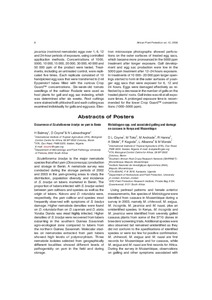| dc.contributor.author | Coyne, D.L. |
| dc.contributor.author | Toko, M. |
| dc.contributor.author | Albanna, L. |
| dc.contributor.author | Hanna, R. |
| dc.contributor.author | Sitole, A. |
| dc.contributor.author | Kagoda, F. |
| dc.contributor.author | Andrade, M.I. |
| dc.contributor.author | Marais, M. |
| dc.date.accessioned | 2019-12-04T11:18:44Z |
| dc.date.available | 2019-12-04T11:18:44Z |
| dc.date.issued | 2006 |
| dc.identifier.citation | Coyne, D. L., Toko, M., Andrade, M., Hanna, R., Sitole, A., Kagoda, F., ... & Marais, M. (2006). Meloidogyne spp. and associated galling and damage on cassava in Kenya and Mozambique (p. 8-9). Poster Unpublished. |
| dc.identifier.uri | https://hdl.handle.net/20.500.12478/3303 |
| dc.description.abstract | Using perineal patterns and female anterior measurements, five species of Meloidogyne were identified from cassava in Mozambique during a survey in 2003, namely M. chitwoodi, M. exigua,M. incognita, M. javanica and M. naasi, plus an unidentified species. In Kenya, M. incognita andM. javanica were identified from severely galled cassava plants from some of the 3710 clones inbreeders’ screening trials. Additional species were also observed but remained unidentified as they did not conform to the specifications of identified species or were too few for positive confirmation. M. chitwoodi, M. exigua and M. naasi are first records for Mozambique and for cassava, whileM. exigua and M. naasi are first records for Africa. During the survey in Mozambique, observations on galling and other symptoms associated with Meloidogyne spp. were also undertaken throughout the main cassava-growing provinces. Tenplants per field (n = 202) were evaluated for galling damage in terms of number of galls per 50 cm feeder roots per plant. Meloidogyne spp. were identified by collecting and 10 females per sample from galled root material were preserved in lactophenol. M. incognita was identified more often than other Meloidogyne spp., followed by M.chitwoodi. The severity of Meloidogyne spp. galling, expressed as number of galls per root, was generally slight but galling was observed in the majority offields across the country. Some fields recorded moderate to severe galling. Severe damage to some of the breeding lines in Kenya provides evidence of resistance against Meloidogyne spp. in cassava and possible genotype × Meloidogyne spp. interaction. Observation of an unidentified Meloidogynesp., as well as the newly recorded species, provides additional justification for a methodical examination and documentation of Meloidogyne spp. occurring on key crops in Africa, towards identification and development of resistant cultivars. |
| dc.language.iso | en |
| dc.subject | Meloidogyne Spp. |
| dc.subject | Cassava |
| dc.subject | Galling |
| dc.title | Meloidogyne spp. and associated galling and damage on cassava in Kenya and Mozambique |
| dc.type | Poster |
| cg.contributor.affiliation | International Institute of Tropical Agriculture |
| cg.contributor.affiliation | Southern African Root Crops Research Network, Mozambique |
| cg.contributor.affiliation | Instituto Nacional de Investigãçao Agronómica, Mozambique |
| cg.contributor.affiliation | University of Jordan |
| cg.contributor.affiliation | Plant Protection Research Institute, South Africa |
| cg.coverage.region | Africa |
| cg.coverage.region | East Africa |
| cg.coverage.region | Southern Africa |
| cg.coverage.country | Kenya |
| cg.coverage.country | Mozambique |
| cg.authorship.types | CGIAR and developing country institute |
| cg.iitasubject | Pests Of Plants |
| cg.iitasubject | Cassava |
| cg.iitasubject | Plant Breeding |
| cg.accessibilitystatus | Limited Access |
| local.dspaceid | 94977 |

